





Any plant with a name as odd as Egyptian walking onion has to be a pretty interesting plant. Egyptian walking onions, also known as tree onions or topset onions, make a great edible conversation piece in the garden.
Egyptian walking onions (Allium cepa var. proliferum) are unique in that they grow bulblets on top of their stalks where normal alliums would grow flowers. As the bulblets form at the top of the green onion-like foliage, they weigh down the stem pulling it to the ground where they can grow new plants. They will continue to do this, literally walking across your garden, thus the name!
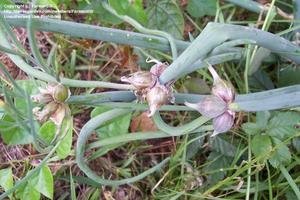
Egyptian walking onions are considered heirlooms, said to date back to at least the 1850s (from the PlantFiles entry), though their history is seemingly unknown. They are also little known in the gardening world, although people that grow them love to have them in their herb, vegetable, or even border beds. On top of their usefulness as an herb and vegetable, Egyptian walking onions are some of the hardiest plants in the garden. They are cold hardy to Zone 3, and can remain evergreen through a Zone 5 winter. They are some of the first plants to show their face in spring and can be counted on year after productive year. They serve as a dialogue starter, not to mention a great source of spicy-flavored onions almost year round.
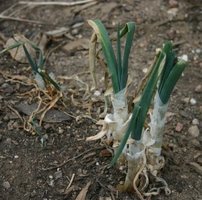 Egyptian walking onions in the dead of winter
Egyptian walking onions in the dead of winter
Preparing Walking Onions
The entire plant is edible, from the underground onion bulb to the hollow green stalks to the small air-bound bulblets. Their compact size packs a zesty punch, but can be used in the place of regular onions in just about any recipe.
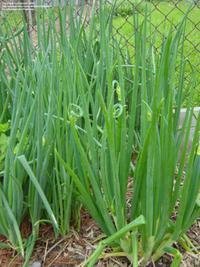
Pickled Egyptian Onions
Ingredients:
1 cup Egyptian onion bulblets (about 1/2-inch wide)
2/3 cup seasoned rice vinegar
(or 1/2 cup rice vinegar plus 3 tablespoons sugar, and salt to taste)
Separate bulblets, trim ends, peel, rinse, and drain. In a 1 to 2 quart pan, combine bulblets and vinegar. Bring to a boil over high heat; boil, uncovered, for 1 minute. Pour into a wide-mouthed jar; cover. Cool, and chill at least 1 day or up to 1 month. Makes 1 cup.
(Originally published in Sunset Magazine 1993, reprinted by Old Fashioned Living [1])
Other recipes in which to consider substituting walking onions:
Miso Soup - substitute chopped walking onion stems for scallions, added at the end of the heating process.
Sweet Onion Salad Dressing - Substitute or supplement Vidalias or shallots for a spicier take on this sweet salad dressing.
Salad Garnishing - Consider topping any salad with chopped stems or the red-toned bulblets as an adornment.
Fried Onions - Peel and fry up the petite bulblets with bread crumbs or just with oil. Yum!
Straight Up - Some brave people will swear by popping raw bulblets in their mouth "like popcorn" for a mid-gardening snack [2].
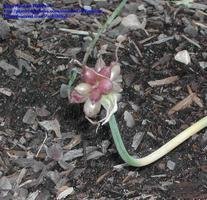
Growing Walking Onions
Growing walking onions is not difficult like some other vegetables. You can start a new plant from the bulblet sets or from the basal onions. Plant in fertile soil just as you would plant any other small onion, about ½ to 1 inch below the surface. Many companies offer starter sets of walking onions and they are also extremely easy to get going from small starts from fellow gardeners. They will begin to colonize and "walk" within the first year, so be prepared to harvest and share!
To harvest: You can harvest the green stems at any point for use in cooking; the bublets can be harvested in mid to late summer through the fall for eating and cooking; you can also harvest the onions at the base of the plant at this time, too [2]. Storage is the same for other small onion types; refrigeration may prolong their keep. The top-sets may be stored like garlic for later use [3].
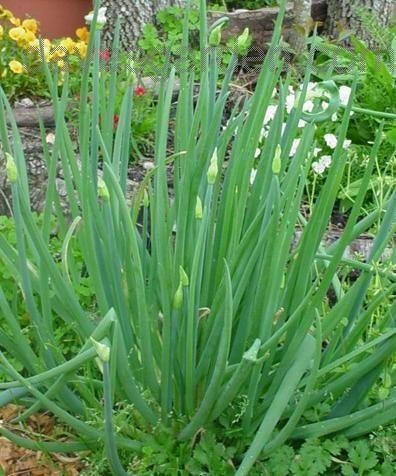
Walking onions are not invasive as the name might allude; they can be controlled easily by "deadheading" the top-sets when you don't want them to spread and by removing any fallen bulblets off the ground. In the fall you can harvest the plant hard, back to only a couple underground onions to keep the plant in check. In total though, one clump can easily be confined to a couple square feet.
If you don't already grow Egyptian walking onions in your garden, consider purchasing or trading for a few sets to get started. They are truly an enjoyable plant to have in the garden and use in the kitchen.
Copyright © www.100flowers.win Botanic Garden All Rights Reserved